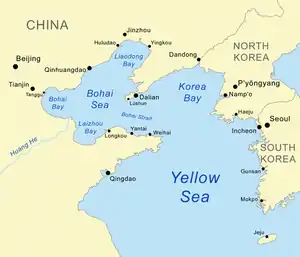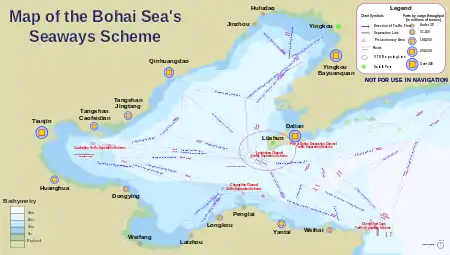Bohai Sea
The Bohai Sea or Bo Sea, also known as Bohai Gulf, Bo Gulf or Pohai Bay (Chinese: 渤海; lit. 'Bo Sea'), is a marginal sea approximately 78,000 km2 (30,000 sq mi) in area on the east coast of mainland China. It is the northwestern and innermost extension of the Yellow Sea, to which it connects to the east via the Bohai Strait.
| Bohai Sea | |||||||||||||||||||||||||
|---|---|---|---|---|---|---|---|---|---|---|---|---|---|---|---|---|---|---|---|---|---|---|---|---|---|
 | |||||||||||||||||||||||||
| Chinese name | |||||||||||||||||||||||||
| Chinese | 渤海 | ||||||||||||||||||||||||
| |||||||||||||||||||||||||
| Korean name | |||||||||||||||||||||||||
| Hangul | 보하이해 | ||||||||||||||||||||||||
| Hanja | 渤海 | ||||||||||||||||||||||||
| |||||||||||||||||||||||||

A medium-sized gulf, the Bohai Sea is enclosed by four provinces from three different regions of China — Liaoning (of Northeast China), Hebei and the Tianjin municipality (of North China), and Shandong (of East China). The whole of the Bohai Sea is considered part of both the internal waters of the People's Republic of China and the center of the Bohai Economic Rim. Its proximity to the Chinese capital of Beijing makes it one of the busiest seaways in the world.
History
Until the early 20th century, Bo Hai was often called the Gulf of Chihli (Chinese: 直隸海灣; pinyin: Zhílì Hǎiwān) or the Gulf of Pechihli or Pechili (北直隸海灣; Běizhílì Hǎiwān). Chihli and Pechihli (North Chihli) were historic provinces in the area surrounding Beijing.
Geography
There are three major bays inside the Bohai Gulf: Laizhou Bay to the south, Bohai Bay to the west, and Liaodong Bay to the north. The provincial-level administrative divisions that have a coastline to the Bohai Sea are, from the south going clockwise: Shandong, Hebei, Tianjin (Tientsin), Hebei again, and Liaoning. Some of the major rivers draining into the gulf include the Yellow River, Xiaoqing River, Hai River, Luan River, Dai River, Daling River, Xiaoling River, Liao River and Daliao River. There are a few important oil reserves in the vicinity of the gulf, including the Shengli Field. Important islands or island groups in the gulf include the Changshan Archipelago (长山列岛; 長山列島), Juehua Island (觉华岛; 覺華島), Bijia Mountain (笔架山; 筆架山), Changxing Island (长兴岛; 長興島), Xizhong Island (西中岛; 西中島), the East/West Mayi Islands (蚂蚁岛), Zhu Island (猪岛; 豬島) and She Island (蛇岛; 蛇島).
Bohai Strait
The opening of the Bohai Gulf is bounded by Changshan Archipelago between Dalian's Lüshunkou District on the southern tip of Liaodong Peninsula, and the Cape of Penglai on the northernmost protrusion of Shandong Peninsula. Due to its proximity to the capital city Beijing and the population of its surrounding provinces exceeding 210 million, the exit of the Bohai Gulf to the Yellow Sea, the Bohai Strait (渤海海峡; 渤海海峽), has become one of busiest sea routes in recent times. Due to the Changshan Island Chain traversing the southern half of the strait, the Bohai Strait is subdivided into several channels:
(From north to south, the most commonly used ones in bold)
- Laotieshan Channel (老铁山水道), also known as the Lau-ti-shan Channel, is the widest and deepest
- Daqin Channel (大钦水道)
- Xiaoqin Channel (小钦水道)
- North Tuoji Channel (北砣矶水道)
- South Tuoji Channel (南砣矶水道)
- Changshan Channel (长山水道), is the most direct route to Tianjin
- Dengzhou Channel (登州水道), also known as the Miaodao Channel (庙岛水道) or Miaodao Strait (庙岛海峡), is the nearest to the shore but also the shallowest
Major ports
There are five major ports along the Bohai Sea rim, with throughputs over 100 million tons, though the port of Tangshan is further subdivided into Jingtang and Caofeidian:

- Port of Yingkou (营口港; 營口港)
- Qinhuangdao Port (秦皇岛; 秦皇島港)
- Port of Jingtang (京唐港)
- Port of Tangshan (唐山港)
- Port of Tangshan Caofeidian (曹妃甸港)
- Tianjin Port (天津港)
- Port of Huanghua (黄骅港; 黃驊港)
Caofeidian and Jingtang are usually treated as one port for statistical purposes. The ports of Dalian and Yantai are also traditionally considered part of the Bohai rim, even though strictly speaking they lie outside the limits of the sea. The Port of Longkou reached 70 million tons of cargo in 2013, and is expected to reach the 100 million ton landmark in the near future.[1]
Major cities along the Bohai Sea coast

Hydrocarbon resources
The Bohai Bay contains significant oil and gas reserves, which provide much of China's offshore production. The main field in the region, named Shengli, has been exploited since the 1960s. It still produces about half a million barrels a day, but is declining.[2] Production is dominated by Chinese majors (China National Offshore Oil Corporation was mostly created for this region) but foreign companies including ConocoPhillips,[3] Roc Oil Company,[4] are present. The Gudao Field, located in the Zhanhua sedimentary basin, was discovered in 1968, based on gravity, magnetic and seismic surveys conducted between 1963–1964.[5] The reservoir includes the Guantao (Miocene) and Minghuazhen (Pliocene) geologic formations within the dome-like anticline.[5] The Suizhong 36-1 Oil Field was discovered in 1987, and produces from Oligocene fluvial-deltaic and lacustrine sandstones.[6] Oil spills have been reported frequently in this region: three spills occurred in a two-month timeframe in 2011.[7]
Tunnel crossing
In February 2011, the PRC announced that it would build a road and rail tunnel across the Bohai Strait to connect the Liaodong and Shandong peninsulas. When completed, the tunnel would be 106 kilometers (66 mi) long.[8] This plan seems to have been superseded as of July 2013, with a modified plan involving a 123-kilometer (76 mi)-long tunnel between Dalian, Liaoning and Yantai, Shandong.[9] The overall concept had its origins in a 1994 plan, which had been intended for completion by 2010 at a cost of $10 billion.
References
- http://www.chinanews.com/gn/2013/12-23/5652663.shtml
- China. Background. US Energy Information Administration
- [https://www.conocophillips.com/operations/asia-pacific-middle-east/ Asia Pacific & Middle East]. ConocoPhillips
- Roc Oil begins Bohai Bay oil production Archived 16 March 2012 at the Wayback Machine. Bairdmaritime. 14 May 2009
- Sizhong, C., and Ping, W., 1980, Geology of Gudao Oil Field and Surrounding Areas, in Giant Oil and Gas Fields of the Decade: 1968-1978, AAPG Memoir 30, Halbouty, M.T., editor, Tulsa: American Association of Petroleum Geologists, ISBN 0891813063, Pp. 471-486
- Gustavson, J.B., and Gang, X.S., 1992, The Suizhong 36-1 Oil Field, Bohai Gulf, Offshore China, In Giant Oil and Gas Fields of the Decade, 1978-1988, AAPG Memoir 54, Halbouty, M.T., editor, Tulsa: American Association of Petroleum Geologists, ISBN 0891813330
- China: Third Oil Spill in Bohai Sea in Less than Two Months. Offshore Energy Today (12 July 2011). Retrieved on 2011-08-03.
- Asahi Shimbun, "China To Build Undersea Tunnel Crossing Bohai Strait", 18 February 2011.
- "'China plans world's longest sea tunnel at $42 billion -report". Reuters. 11 July 2013.
External links
| Wikimedia Commons has media related to Bohai Sea. |